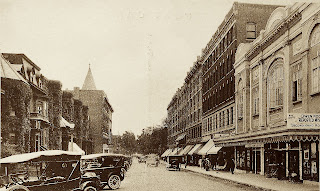William Stiles Loomis
The town of Holyoke was only a year old when the Loomis family moved here in 1851. His father, Elijah W. Loomis, owned and operated a variety and convenience store on High street, while his mother, Janet Stiles Loomis, kept an oyster house and confectionary on the same block.
The Loomis ancestry in this country traced back to Joseph Loomis, an emigrant from England in1639. He attended the Holyoke public school system, and graduated from Holyoke High School when it was still a single floor of Chapin’s Hall on the corner of Race and Dwight street.
After returning from his service in the Civil War, Loomis bought his father’s store with his brother-in-law, Edgar J. Pomeroy. An interest in journalism led Loomis to become joint owner of the Holyoke Transcript in 1872 with E.L. Kirtland.
The Transcript was then published weekly, and shortly after Loomis purchased Kirtland’s share of the company in 1875 it became the leading newspaper in the city. William G. Dwight became a partner in the company in 1882, and in October of the same year they published the first edition of the Daily Transcript.
Loomis widened the newspaper’s scope and influence until he transferred his ownership share to Dwight in 1887. The foundational success and development Loomis contributed to the Holyoke Transcript made it the incredible historical resource it is today.
In 1888 Loomis bought the majority share of the Railway Company. He promptly extended the lines into Elmwood section of the city, and the company expanded every year of his ownership. In 1897, the state granted permission to build a resort destination at Little Mountain, later known as Mountain Park.
Loomis planned and executed a zoo, observation towers, restaurants, merry-go-round, and the Mountain Park Casino which held musicals and operas. That same year the Holyoke Water Power offered to the library the land bound by Maple, Essex, Chestnut, and Cabot as a gift.
Loomis served as the Chairman of a fundraising committee which raised $95,000 for a new library building. The construction of the main library building completed in 1901, and the dedication and opening occurred in January of 1902.
Loomis was also Vice President of Holyoke Savings Bank upon his death in July of 1914, and donated the land for the Loomis House.
Frank Wilcox, Director of the Holyoke Public Library from 1900 to 1946, said the “greatest service was doubtless in connection with securing of the present building for the library…
The building will always stand as a proud monument to the generosity...and [be] no less a memorial of the public spirit, unselfish labors and high interests” of William Stiles Loomis. (Appleton Publishing)











